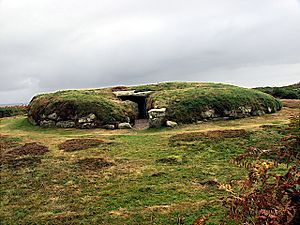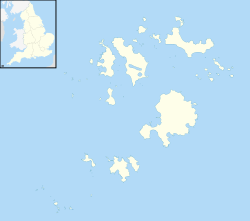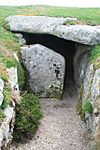Porth Hellick Down facts for kids

Great Tomb at Porth Hellick Down
|
|
| Region | Isles of Scilly |
|---|---|
| Coordinates | 49°55′06″N 6°16′52″W / 49.91829°N 6.28113°W |
| Type | Entrance grave |
| History | |
| Founded | c.2000-1500 BC |
| Site notes | |
| Excavation dates | 1899 |
| Archaeologists | George Bonsor |
| Official name | Porth Hellick Down |
| Designated | 1975 |
| Reference no. | 304047 |
Porth Hellick Down is an amazing ancient site on St Mary's island. It's part of the Isles of Scilly in Great Britain. This special place was used by people thousands of years ago. It dates back to the Neolithic (New Stone Age) and Bronze Age. Imagine a huge old cemetery with many stone mounds called cairns. Some of these cairns have special doors, leading to burial rooms inside. These are called entrance graves. Porth Hellick Down has the biggest collection of these entrance graves anywhere!
Contents
Exploring Porth Hellick Down
Porth Hellick Down sits on St Mary's island. It looks out over Porth Hellick Bay. This ancient place, from the Stone and Bronze Ages, is like a giant outdoor museum. It has a big cemetery with many stone burial mounds. At least six of these are entrance graves, which means you can walk inside them. The site also has an old stone wall, called a linear boundary. There's also a prehistoric field system. This system of old fields stretches across the northern and western parts of the Down. It is the largest group of entrance graves still existing in the world.
The Great Tomb: A Special Burial Site
The biggest and best-kept entrance grave at Porth Hellick Down is a Bronze Age grave. It was built between 2000 and 1500 BC. You can find it on the northwestern slope of the Down. This burial monument is close to an ancient field system. An antiquarian named George Bonsor dug here in 1899. He gave this entrance grave its name: "The Great Tomb."
Before Bonsor's dig, others had explored the tomb. They didn't record what they found. So, when Bonsor arrived, the burial room was empty. He only found a piece of pumice stone and some broken pottery from the late Bronze Age. Bonsor's work was important. It was the first time an excavation in Scilly was written down in detail.
The Great Tomb sits on a low, round platform. The mound itself is about 12.25 meters (40 feet) wide. It stands up to 1.6 meters (5 feet) tall. Large stone slabs hold the mound in place. The burial room inside is about 3.5 meters (11.5 feet) long and 1.5 meters (5 feet) wide. It is 1 meter (3 feet) high. Four big stone slabs, called capstones, form the roof. Each capstone is about 2.5 meters (8 feet) long. They are also 1.25 meters (4 feet) wide.
The burial room has a D-shape. Two of its sides slant towards the back of the passage. The entrance passage itself is open to the sky. The Ministry of Works later fixed up The Great Tomb. They added new turf to protect the burial room. But during this work, they accidentally damaged the tomb. They removed the outer stone kerb. Today, English Heritage looks after this important site.
Other Interesting Monuments
One entrance grave on Porth Hellick Down is called the "coffin grave." It's the furthest west of the graves. You can still see parts of its stone kerb. Four capstones cover a chamber shaped like a coffin. The mound has a kerb of large stones. It measures about 8.3 meters (27 feet) by 8 meters (26 feet). The burial room faces east-west, with the entrance facing east.
Inside, the chamber is 7 meters (23 feet) long. It's almost 1.5 meters (5 feet) wide in the middle. Its boat or coffin shape means the sides curve in slightly. It narrows to 1 meter (3 feet) wide at the west end. At the entrance, it's 0.65 meters (2 feet) wide. The entrance is partly blocked. Stone slabs line the chamber walls. Four capstones form the roof. This chamber is a great example of a coffin or boat-shaped burial room.
Another entrance grave on Porth Hellick Down is special. It was built around a huge natural rock outcrop. The builders used this rock as part of the grave's structure. This burial chamber has a round mound of stacked stones. It's 13 meters (43 feet) wide and 1 meter (3 feet) high. The south end of the chamber has large slabs on its west side. A big boulder is on the east side. Another large slab rests on these walls, forming the roof. This grave is mostly still in its original shape. It has only lost one of its capstones. Using a natural rock outcrop in a grave is very unusual for an entrance grave in Scilly.
Porth Hellick Down also has an ancient linear boundary. This is like a very old fence or wall. It runs along the eastern slope. The boundary is a nearly straight line of small upright stones. These stones are up to 0.5 meters (1.5 feet) high. They are spaced 1.5 to 6 meters (5 to 20 feet) apart. Starting at the eastern edge, it stretches southeast to northwest for 17 meters (56 feet). Then it continues for another 23 meters (75 feet). The boundary is about 1 meter (3 feet) wide and 0.1 meters (0.3 feet) high. It's mostly covered by heather turf. These linear boundaries are not common in prehistoric Britain. But the Isles of Scilly has several of them. They are often found near groups of ancient burial monuments.
Gallery
Images for kids








